
Purmerend is a city and municipality in the west of the Netherlands, in the province of North Holland and in the region of West Friesland. The city is surrounded by polders, such as the Purmer, Beemster and the Wormer. The city became the trade center of the region but the population grew relatively slowly. Only after 1960 did the population start to grow from around 10,000 to around 80,000 by the 2010s. From the 1960s onwards, Purmerend has seen major expansion and continues to do so. This expansion has turned Purmerend into a commuter town; many inhabitants of Purmerend work, go to school or spend their leisure time in Amsterdam. Purmerend is part of the Randstad, one of the largest conurbations in Europe.

West Friesland is a contemporary region in the Northwest of the Netherlands, in the province of North Holland.

Watergang is a village in the northwest Netherlands. It is located in the municipality of Waterland, North Holland, about seven kilometres north of Amsterdam, on the east bank of the Noordhollandsch Kanaal.

Halfweg is a village in the Dutch province of North Holland. Previously a part of the municipality of Haarlemmerliede en Spaarnwoude, it is currently a part of the municipality of Haarlemmermeer and lies about 8 km (5.0 mi) east of Haarlem. Its name, which translates as "halfway," comes from its location approximately halfway between Haarlem and Amsterdam.
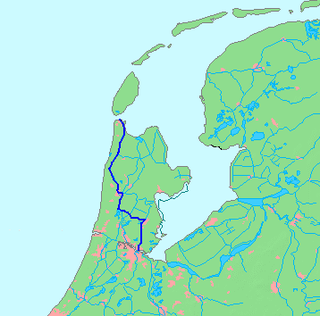
The Noordhollandsch Kanaal is a canal originally meant for ocean-going ships. It is located in North Holland, Netherlands. The canal was of great significance in Dutch history.

Amsterdam-Noord is a borough of Amsterdam, Netherlands with a population of about 90,000. The IJ, the body of water which separates it from Amsterdam-Centrum and the rest of the city, is situated southwest of Amsterdam-Noord. The borough, which has an area of 49.01 km2, borders the municipalities of Zaanstad, Oostzaan, Landsmeer and Waterland to the north, all part of the province of North Holland like Amsterdam. It borders the Markermeer to the east.

Schellingwoude is a neighbourhood of Amsterdam, Netherlands. A former village located on the northern shore of the IJ, in the province of North Holland, it was a separate municipality between 1817 and 1857, when it was merged with Ransdorp; the latter merged with Amsterdam in 1921. Nowadays it is part of the Amsterdam-Noord borough and the Landelijk Noord district.

Amsterdam Bijlmer ArenA, previously named Amsterdam Bijlmer (1971–2006), is a railway station in the Bijlmermeer neighbourhood of stadsdeel (borough) Amsterdam-Zuidoost in Amsterdam, Netherlands. The station has five platforms and eight tracks; two for the Amsterdam Metro and six train tracks, along with a bus station. Train services are operated by Nederlandse Spoorwegen.
Weidevenne is a district of Purmerend in the Netherlands, west of the Noordhollandsch Kanaal across from the De Gors district. Its 14,451 inhabitants mainly live in terraced houses. The population of Purmerend is expected to grow to 90,000, mainly due to the continuing expansion of Weidevenne. In November 2007 the district celebrated its tenth anniversary.
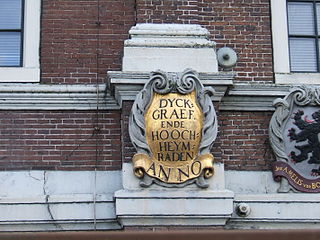
In the Netherlands, a water board, water council or water authority is a regional governing body solely charged with the management of surface water in the environment. Water boards are independent of administrative governing bodies like provinces and municipalities. In general, they are responsible for managing rivers and canals, issues with the flow of watercourses and drainage issues, water collection, flood and erosion prevention and provision of potable water. They manage polder systems, water levels, water barriers and locks, enforcements, water quality and sewage treatment in their respective regions. The concept of a coordinating "High Water Authority" (Hoogheemraadschap) originated in what now is the province of South Holland in the 12th century.

The Rhine–Meuse–Scheldt delta is a river delta in the Netherlands formed by the confluence of the Rhine, the Meuse and the Scheldt rivers. In some cases, the Scheldt delta is considered a separate delta to the Rhine–Meuse delta. The result is a multitude of islands, branches and branch names that may at first sight look bewildering, especially as a waterway that appears to be one continuous stream may change names as many as seven times, e.g. Rhine → Bijlands Kanaal → Pannerdens Kanaal → Nederrijn → Lek → Nieuwe Maas → Het Scheur → Nieuwe Waterweg. Since the Rhine contributes most of the water, the shorter term Rhine Delta is commonly used. However, this name is also used for the delta where the Alpine Rhine flows into Lake Constance, so it is clearer to call the larger one Rhine–Meuse delta, or even Rhine–Meuse–Scheldt delta, as the Scheldt ends in the same delta. By some calculations, the delta covers 25,347 km2 (9,787 sq mi), making it the largest in Europe.

Purmer is a polder and reclaimed lake in the Netherlands province of North Holland, located between the towns of Purmerend and Edam-Volendam. It is also a village located in the municipalities of Waterland and Edam-Volendam.
Buikslotermeer is a neighborhood and a polder of Amsterdam, Netherlands. The Buikslotermeer is a reclaimed lake, now largely located within the city of Amsterdam-Noord. Nowadays, the name 'Buikslotermeer' is used to refer to the entire Buikslotermeerpolder of the similarly named neighborhood, located in the south-east of the polder.
Floradorp is a neighborhood of Amsterdam-Noord, Netherlands in the Dutch province of North Holland. The neighborhood is bordered in the north by the Buiksloterdijk, in the east by the Noorderpark and the Noordhollandsch Kanaal, in the west by the Klaprozenweg and in the south by the Sneeuwbalstraat in the Bloemenbuurt. The majority of street names in both the Bloemenbuurt and Floradorp are named after flowers and plants. By the Noord borough, the neighborhood is classified as part of the Volewijck.
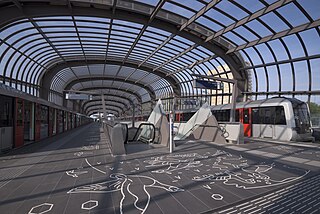
Station Noord is the northernmost station of the Amsterdam Metro's Route 52 in Amsterdam, Netherlands. The line and station were opened on 22 July 2018.

Vlotbrug translates from Dutch into English as "float bridge". In its broadest sense, it includes pontoon bridges. In a narrower sense, it includes floating swing bridges which pivot either centrally or from one or both banks of a body of water to allow vessels to pass through.
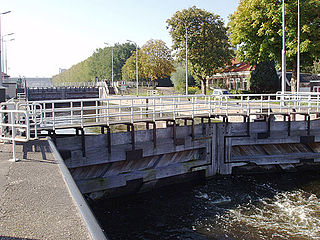
Willem I Lock is a monumental lock in Amsterdam-Noord.

Koopvaarders Lock in Den Helder, Netherlands connects the Noordhollandsch Kanaal to the Nieuwediep. There were 4 locks at Nieuwediep carrying this name.
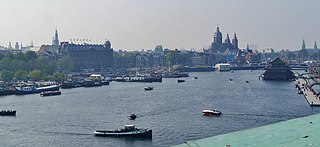
The Oosterdok is a former wet dock in Amsterdam. It was created in 1831-1832 by constructing the Oosterdoksdam and the Oosterdoksluis, forming a reliable deep port closed off from the tidal IJ.
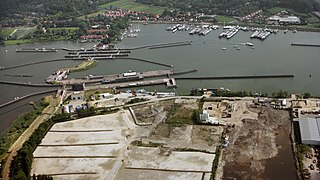
The Oranje Locks are a group of locks and other water management facilities just east of Amsterdam.

















